Mercuriceratops gemini – Incredible Diversity of Late Cretaceous Ceratopsians
Researchers have described a new genus of ceratopsian, based on fossils excavated from Montana (western United States) and Alberta (Canada). The dinosaur has been named Mercuriceratops (M. gemini) and when fully grown, this heavy-weight herbivore, would have weighed as much as an Asian elephant and measured around six metres in length. Mercuriceratops lived around seventy-seven million years ago (mid Campanian faunal stage) and the formal, scientific paper describing this new genus has been published in the journal Naturwissenschaften (the science of nature).
Mercuriceratops gemini
Mercuriceratops (pronounced Murr-cure-ree-sera-tops), means “Mercury horned face”, this chasmosaurine has been named after the wing-like protrusions on the side of its neck frill. The “wings” are formed from the squamosal skull bones which are hatchet shaped and stick out from the side in a much more prominent manner than in any other known species of ceratopsian. In addition, the the back of the squamosal is modified to form a narrow bar that would have supported the side of a very robust parietal skull bone. These unusually shaped squamosals reminded the research team of the wings on the helmet of the Roman god Mercury.
An Illustration of Mercuriceratops gemini
Picture credit: Danielle Dufault
A Member of the Chasmosaurinae
Related to chasmosaurines such as Pentaceratops and Triceratops, the research team have proposed that this dinosaur too, had two long brow horns and a shorter nose horn, just like the later chasmosaurine dinosaurs Pentaceratops and Triceratops. Two large horns over the eyes (brow horns) is very typical of the Chasmosaurinae.
Models of the Chasmosaurine Dinosaurs Pentaceratops (left) Triceratops (right)
Picture credit: Everything Dinosaur
The picture above show models of typical chasmosaurine dinosaurs, note the large horns over the eyes. The models are from the Schleich World of History Model series.
To view Schleich’s range of prehistoric animal models: Schleich Prehistoric Animal Models.
The trivial or specific name – “gemini” refers to the almost identical fossil specimens that were found and led to the description of this new genus of horned dinosaur. One fossilised squamosal bone comes from Upper Cretaceous strata of north, central Montana, the second comes from rocks found in the famous Dinosaur Provincial Park Formation of Alberta. Mercuriceratops represents the oldest chasmosaurine dinosaur known from Canada and the first pre-Maastrichtian ceratopsian to have been found in both the USA and Canada.
A Picture Showing the Two Squamosal Bones (right side of the skull)
Picture credit: Naturwissenschaften
Unusual Squamosal Bones
Commenting on the unusual shape of the squamosal bones, lead author of the scientific paper Dr Michael Ryan (Curator of Vertebrate palaeontology at the Cleveland Museum of Natural History), stated:
“Mercuriceratops took a unique evolutionary path that shaped the large frill on the back of its skull into protruding wings like the decorative fins on classic 1950’s cars. It definitively would have stood out from the herd during the Late Cretaceous. Horned dinosaurs in North America used their elaborate skull ornamentation to identify each other and to attract mates, not just for protection from predators. The wing-like protrusions on the sides of its frill may have offered male Mercuriceratops a competitive advantage in attracting mates.”
Recently, palaeontologists have begun to piece together a picture of the North American fauna in the Late Cretaceous. The fauna of Laramidia (the long, narrow strip of land that made up the western shores of the Western Interior Seaway), was extremely varied. This newly named dinosaur genus reinforces the biogeographical differences between the northern and southern faunal provinces of the Campanian of North America. Having said that, this dinosaur must have been quite wide ranging with something like 380 kilometres between the two fossil finds.
Co-author of the Naturwissenschaften paper, Dr David Evans (Royal Ontario Museum), explained:
“The butterfly-shaped frill, or neck shield, of Mercuriceratops is unlike anything we have seen before. Mercuriceratops shows that evolution gave rise to much greater variation in horned dinosaur headgear than we had previously suspected.”
The new dinosaur is described from skull fragments from two individuals collected from the Judith River Formation of Montana and the Dinosaur Park Formation of Alberta. The Montana specimen was originally collected on private land and acquired by the Royal Ontario Museum. The Dinosaur Provincial Park specimen was collected by Susan Owen-Kagen, a preparator in Professor Philip Currie’s lab at the University of Alberta.
Dr Ryan added:
“Susan showed me her specimen during one of my trips to Alberta. I instantly recognized it as being from the same type of dinosaur that the Royal Ontario Museum had from Montana.”
For Philip Currie, the Dinosaur Provincial Park specimen confirmed the the Montana fossil was a true and accurate representation of the dinosaur’s squamosal. In many instances, fossilised bones can become distorted and crushed as a result of the fossilisation process. The altered morphology can lead to a great deal of confusion when it comes to identifying characteristics. Pathology such as disease or damage to the bone that occurred when the animal was alive could also have led to the strange shape of the squamosal, however, with two squamosals from the right side of the skull being virtually identical there is a very strong probability that these fossils represent a new chasmosaurine with a unique neck crest shape.
As the eminent Canadian palaeontologist Philip Currie noted:
“The two fossils – squamosal bones from the side of the frill, have all the features you would expect, just presented in a unique shape.”
A Picture of the Dig Site (Dinosaur Provincial Park – Alberta)
Picture credit: Professor Phil Currie (University of Alberta)
Dr Mark Loewen (Natural History Museum of Utah), another co-author of the paper added:
“This discovery of a previously unknown species in relatively well-studied rocks underscores that we still have many more new species of dinosaurs to left to find.”
The wing-like flanges would have made a striking visual image, especially if the head and neck of these dinosaurs were brightly coloured. The horns too, although, undoubtedly used for defence and intra-specific combat would also have played a role in signalling amongst members of the herd.
The ceratopsians are spilt into two distinct groups, the Chasmosaurinae which were characterised by having long neck frills and in most cases short nasal horns but large brow horns. The second group are known as the centrosaurines, or the short-frilled ceratopsians. This does not mean that the frills on this group were small, most of the centrosaurines had frills that were heavily augmented with spikes and horns. These dinosaurs tended to have short brow horns but with larger nose horns as a general rule. Both types of ceratopsian were very common in North America during the Late Cretaceous and a number of different genera have been identified.
The Frill Size and Ornamentation of Mercuriceratops Compared to a Typcial Centrosaurine and Chasmosaurine
Picture credit: Danielle Dufault
CollectA introduced a model of Mercuriceratops (M. gemini) into their Prehistoric Life model range in 2016.
The CollectA Mercuriceratops Dinosaur Model
To view the CollectA Prehistoric Life range: CollectA Prehistoric Life Models and Figures.
Everything Dinosaur acknowledges the help of the press room at the Cleveland Museum of Natural History in the compiling of this article.


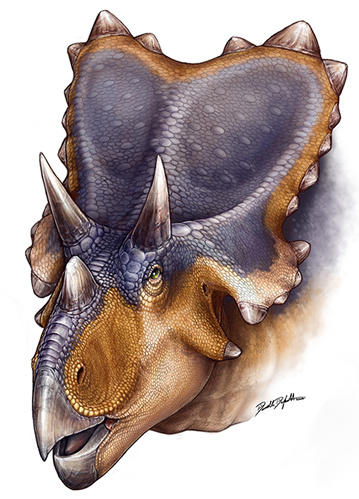
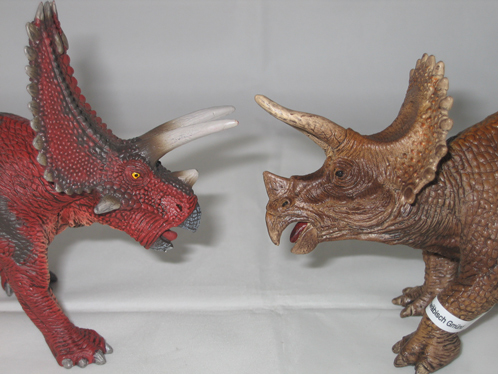
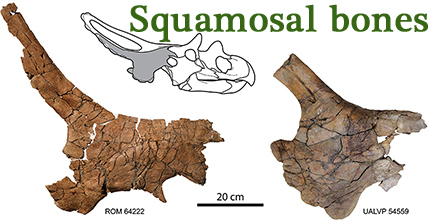
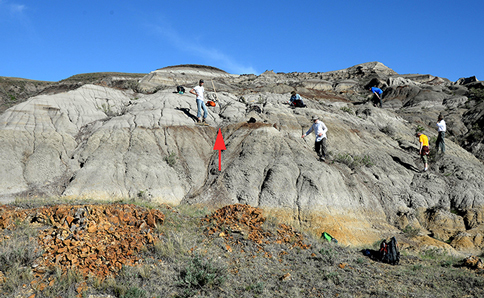
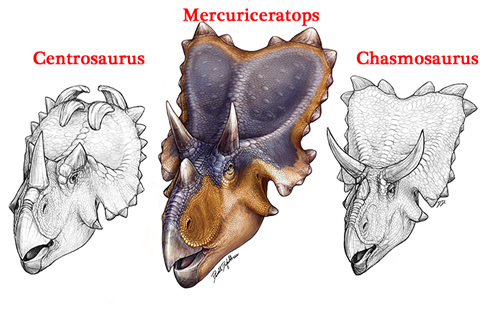
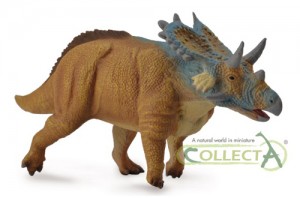




Yet another Ceratopsian ! How many of these things are there ? Or is it possible they are just variations within the large populations of the more well-known species.
Is this another potential model for CollectA ?
It’s a big problem with the Ceratopsians, shield morphology changes as the animals grew and matured. However, in Laramidia there seems to be a whole range of different Chasmosaurs and Centrosaurs, currently there is a “golden age” of horned dinosaur discoveries, hopefully, there will be further evidence of their presence elsewhere in the world published soon. As for the Collecta range, we have proposed some better known Ceratopsians for models, most notably Protoceratops, we shall have to see. Good news the rest of the 2014 collection will be with us in a few weeks.